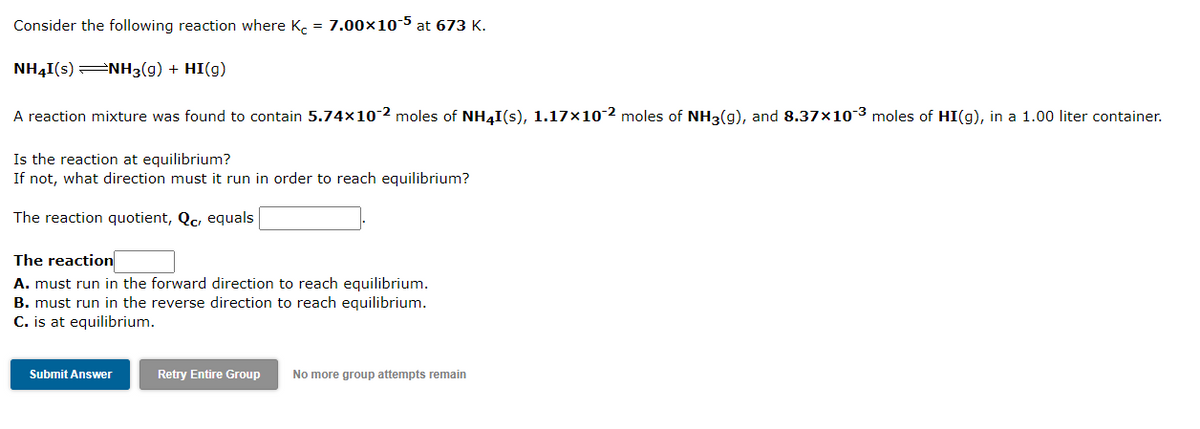Consider the following reaction where Ke = 7.00×10-5 at 673 K. NHẠI(s)=NH3(g) + HI(g) A reaction mixture was found to contain 5.74×10-2 moles of NH4I(s), 1.17×10-2 moles of NH3(g), and 8.37×10´³ moles of HI(g), in a 1.00 liter container. Is the reaction at equilibrium? If not, what direction must it run in order to reach equilibrium? The reaction quotient, Qc, equals The reaction A. must run in the forward direction to reach equilibrium. B. must run in the reverse direction to reach equilibrium. C. is at equilibrium. Submit Answer Retry Entire Group No more group attempts remain
Consider the following reaction where Ke = 7.00×10-5 at 673 K. NHẠI(s)=NH3(g) + HI(g) A reaction mixture was found to contain 5.74×10-2 moles of NH4I(s), 1.17×10-2 moles of NH3(g), and 8.37×10´³ moles of HI(g), in a 1.00 liter container. Is the reaction at equilibrium? If not, what direction must it run in order to reach equilibrium? The reaction quotient, Qc, equals The reaction A. must run in the forward direction to reach equilibrium. B. must run in the reverse direction to reach equilibrium. C. is at equilibrium. Submit Answer Retry Entire Group No more group attempts remain
Chemistry
10th Edition
ISBN:9781305957404
Author:Steven S. Zumdahl, Susan A. Zumdahl, Donald J. DeCoste
Publisher:Steven S. Zumdahl, Susan A. Zumdahl, Donald J. DeCoste
Chapter13: Chemical Equilibrium
Section: Chapter Questions
Problem 3ALQ: For the reactionH2(g)+I2(g)2HI(g), consider two possibilities: (a) you mix 0.5 mole of each...
Related questions
Question
5.3

Transcribed Image Text:Consider the following reaction where K. = 7.00×10-5 at 673 K.
NH4I(s)=NH3(g) + HI(g)
A reaction mixture was found to contain 5.74×10-2 moles of NH4I(s), 1.17×10 2 moles of NH3(g), and 8.37×10-3 moles of HI(g), in a 1.00 liter container.
Is the reaction at equilibrium?
If not, what direction must it run in order to reach equilibrium?
The reaction quotient, Qc, equals
The reaction
A. must run in the forward direction to reach equilibrium.
B. must run in the reverse direction to reach equilibrium.
C. is at equilibrium.
Submit Answer
Retry Entire Group
No more group attempts remain
Expert Solution
This question has been solved!
Explore an expertly crafted, step-by-step solution for a thorough understanding of key concepts.
Step by step
Solved in 2 steps with 2 images

Knowledge Booster
Learn more about
Need a deep-dive on the concept behind this application? Look no further. Learn more about this topic, chemistry and related others by exploring similar questions and additional content below.Recommended textbooks for you

Chemistry
Chemistry
ISBN:
9781305957404
Author:
Steven S. Zumdahl, Susan A. Zumdahl, Donald J. DeCoste
Publisher:
Cengage Learning


Chemistry: An Atoms First Approach
Chemistry
ISBN:
9781305079243
Author:
Steven S. Zumdahl, Susan A. Zumdahl
Publisher:
Cengage Learning

Chemistry
Chemistry
ISBN:
9781305957404
Author:
Steven S. Zumdahl, Susan A. Zumdahl, Donald J. DeCoste
Publisher:
Cengage Learning


Chemistry: An Atoms First Approach
Chemistry
ISBN:
9781305079243
Author:
Steven S. Zumdahl, Susan A. Zumdahl
Publisher:
Cengage Learning

Chemistry: The Molecular Science
Chemistry
ISBN:
9781285199047
Author:
John W. Moore, Conrad L. Stanitski
Publisher:
Cengage Learning

Chemistry for Engineering Students
Chemistry
ISBN:
9781337398909
Author:
Lawrence S. Brown, Tom Holme
Publisher:
Cengage Learning

Chemistry: Principles and Practice
Chemistry
ISBN:
9780534420123
Author:
Daniel L. Reger, Scott R. Goode, David W. Ball, Edward Mercer
Publisher:
Cengage Learning